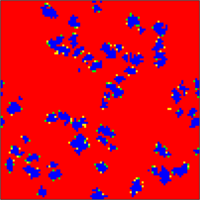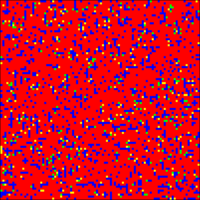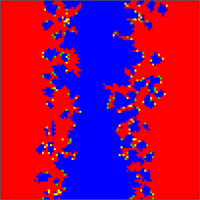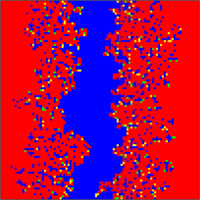Cooperation in structured populations/ Pure strategies
The equilibrium frequencies of cooperators and defectors in structured populations can differ considerably from the results for [mixed.pure.html well-mixed populations] with random encounters. To model spatial structures the individuals are arranged on a lattice and interact only within a limited local neighborhood. Various choices for the lattice geometry are possible: square lattice with neighborhood size [math]\displaystyle{ N = 4 }[/math] or [math]\displaystyle{ N = 8 }[/math], triangular with [math]\displaystyle{ N = 3 }[/math] or hexagonal with [math]\displaystyle{ N = 6 }[/math]. Whenever a site x is updated, the present occupant and all its neighbors compete for recolonizing the focal site x with their offspring. We assume that a neighbor y succeeds in reproducing with a probability proportional to the difference in payoffs [math]\displaystyle{ P_x - P_y }[/math] provided it is positive and with probability zero otherwise. In well-mixed populations, this assumption leads to the replicator equation. A spatial analogue of the replicator dynamics is then to set the competitive success of neighbor y proportional to
- [math]\displaystyle{ w_y = (P_x - P_y)_+/\alpha }[/math]
where [math]\displaystyle{ \alpha }[/math] is a normalization constant such that [math]\displaystyle{ 0 \lt w_y \lt 1 }[/math] holds ([math]\displaystyle{ \alpha = T - S }[/math] in the Prisoner's Dilemma and [math]\displaystyle{ \alpha = T - P }[/math] in the Snowdrift or Hawk-Dove game). With probability [math]\displaystyle{ p_x = (1 - w_{y1})(1 - w_{y2}) ... (1 - w_{yN}) }[/math] all neighbors [math]\displaystyle{ y_i }[/math] fail to reproduce and the focal individual succeeds in placing its own offspring in site x. Otherwise, with probability [math]\displaystyle{ 1 - p_x }[/math], one neighbor takes over the focal site. The relative probability for success of a neighbor y is [math]\displaystyle{ w_y/w }[/math] where [math]\displaystyle{ w = w_1 + w_2 + ... + w_N }[/math].
Updating of the lattice can be synchronous referring to populations with discrete non-overlapping generations or asynchronous for populations with overlapping generations in continuous time. For synchronous updates, all individuals interact and accumulate payoffs and then everbody attempts to reproduce with successrates relative to each individuals payoff within its neighborhood. For asynchronous updates only a single randomly selected focal site gets updated at a time: first the payoffs of the selected individual and all its neighbors are determined and then they compete to re-populate the focal site as outlined above.
Dynamical scenarios
Time evolution of cooperators and defectors in spatially structured populations where individuals interact only within a limited local neighborhood and engage in prisoner's dilemma and snowdrift games.
| Color code: | Cooperators | Defectors |
|---|---|---|
| New cooperator | New defector |
The following examples illustrate and highlight different relevant and interesting scenarios. All examples are meant as suggestions and starting points for further experiments and explorations of the dynamics of the system.

Space promotes cooperation in the Prisoner's Dilemma
In the Prisoner's Dilemma cooperators can thrive in spatial arrangements for sufficiently small [math]\displaystyle{ r }[/math] - recall that the payoffs can be rescaled to[math]\displaystyle{ R = 1 }[/math], [math]\displaystyle{ P = 0 }[/math], [math]\displaystyle{ T = 1 + r }[/math] and [math]\displaystyle{ S = -r }[/math] where [math]\displaystyle{ r }[/math] is the cost-to-benefit ratio as derived in the [index.html#pd definition] of the game. The spatial structure enables cooperators to form compact clusters and thereby reducing explotation by defectors. However, for larger [math]\displaystyle{ r }[/math] the benefit from clustering beomes too small and cooperators go extinct.
The snapshot on the left shows a typical lattice configuration near the extinction threshold of [math]\displaystyle{ r }[/math] where cooperators just manage to persist. In the spatial Prisoner's Dilemma, cooperators can survive through cluster formation.

Space inhibits cooperation in Snowdrift and Hawk-Dove games
In the Prisoner's Dilemma cooperators can thrive in spatial arrangements for sufficiently small [math]\displaystyle{ r }[/math] - recall that the payoffs can be rescaled to[math]\displaystyle{ R = 1 }[/math], [math]\displaystyle{ P = 0 }[/math], [math]\displaystyle{ T = 1 + r }[/math] and [math]\displaystyle{ S = -r }[/math] where [math]\displaystyle{ r }[/math] is the cost-to-benefit ratio as derived in the [index.html#pd definition] of the game. The spatial structure enables cooperators to form compact clusters and thereby reducing explotation by defectors. However, for larger [math]\displaystyle{ r }[/math] the benefit from clustering beomes too small and cooperators go extinct.
The snapshot on the left shows a typical lattice configuration near the extinction threshold of [math]\displaystyle{ r }[/math] where cooperators just manage to persist. In the spatial Snowdrift Game, cluster formation is harder which may inhibit cooperation.

Cluster formation in the spatial Prisoner's Dilemma
In order to get a better understanding of the relevant mechanisms in the spatial prisoner's dilemma, consider a single broad straight stripe of cooperators bounded by defectors. The cost-to-benefit ratio [math]\displaystyle{ r }[/math] is the same as above, i.e. near the extinction threshold of cooperators. Defectors can not penetrate the straight boundary but coopertors can expand. Such unconcerted expansion renders the boundary irregular and now defectors can invade. Small compact clusters of cooperators get separated and meander into the defectors realm. Due to stochastic fluctuations the clusters vary in size. If they grow, they often divide into two, but if they shrink, they are likely wiped out because the clustering advantage of cooperators decreases.
The snapshot on the left shows a typical lattice configuration after 150 Monte-Carlo (MC) steps. In each MC step, every site gets update once on average.

Cluster formation in the spatial Snowdrift and Hawk-Dove games
The relevant mechanisms in the spatial snowdrift or hawk-dove game are quite different from the prisoner's dilemma: only in the beginning they are similar in that the straight boundary of cooperators resists invasion by defectors and cooperators can expand. Cooperators can even grow dendrite like structures into the territory of defectors. Branches may break off but tiny isolated or even single cooperators can persist. Once the boundary is irregular, then defectors are able to invade the domain of cooperators. Related to the dendrites, the defectors reduce the cooperators only to a skeleton like structure. The reason and advantage of such a fine mixing of cooperators and defectors lies in the characteristics of the game: each players best option depends on the neighboring strategies - if they cooperate it is best to defect and vice versa.
The snapshot on the left shows a typical lattice configuration for the same cost-to-benefit ratio [math]\displaystyle{ r }[/math] near the extinction threshold after 50 MCsteps.
The key result that spatial structure promotes cooperation in the Prisoner's Dilemma but fails to do so under the apparently relaxed conditions of the Snowdrift or Hawk-Dove game is very robust. In particular, the qualitative results remain unaffected by changes in the updating of the lattice (synchronous versus asynchronous) or the lattice geometry (square, triangular or hexagonal lattices) leading to different neighborhood sizes. This can be easily veryfied using the EvoLudoLabs and changing e.g. the lattice geometry on the Population tab of the parameter panel.